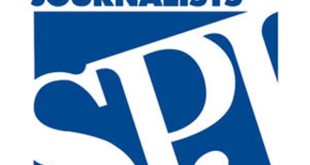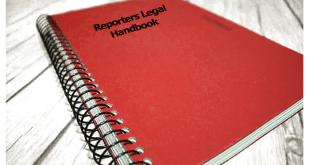NEVADA SUPREME COURT RULES
PART IV
RULES ON ELECTRONIC COVERAGE OF COURT PROCEEDINGS
Rule 229. Definitions and scope.
1. Definitions.
(a) “Judge” means the particular judge, justice, or judicial officer who is presiding over the public proceeding, or his or her designee (e.g., Public Information Officer, Clerk or Court Administrator).
(b) “Proceeding” means any trial, hearing, motion, hearing on an order to show cause or petition, or any other matter held in open court which the public is entitled to attend.
(c) “News reporter” shall include any person who gathers, prepares, collects, photographs, records, writes, edits, reports, or publishes news or information that concerns local, national, or international events or other matters of public interest for dissemination to the public.
(d) “Electronic coverage” means broadcasting, televising, recording or taking photographs by any means, including but not limited to video cameras, still cameras, cellular phones with photographic or recording capabilities or computers.
2. Scope.
(a) These rules do not govern the coverage of a proceeding by a news reporter who is not using a camera or electronic equipment.
(b) Except as provided by these rules, the use of cameras, cellular phones or other electronic devices to photograph or record courtroom proceedings without the express permission of the judge is prohibited.
[Added; effective May 30, 1988; amended effective August 31, 2011.]
Rule 230. Duty of news reporters to obtain permission.
1. News reporters desiring permission to provide electronic coverage of a proceeding in the courtroom shall file a written request with the judge at least 24 hours before the proceeding commences, however, the judge may grant such a request on shorter notice or waive the requirement for a written request. The attorneys of record shall be notified by the court administrator or by the clerk of the court of the filing of any such request by a news reporter. The written order of the judge granting or denying access by a news reporter to a proceeding shall be made a part of the record of the proceedings.
2. Under these rules, there is a presumption that all courtroom proceedings that are open to the public are subject to electronic coverage. A judge shall make particularized findings on the record when determining whether electronic coverage will be allowed at a proceeding, in whole or in part. Specifically, the judge shall consider the following factors:
(a) The impact of coverage upon the right of any party to a fair trial;
(b) The impact of coverage upon the right of privacy of any party or witness;
(c) The impact of coverage upon the safety and well-being of any party, witness or juror;
(d) The likelihood that coverage would distract participants or would detract from the dignity of the proceedings;
(e) The adequacy of the physical facilities of the court for coverage; and
(f) Any other factor affecting the fair administration of justice.
Rule 231. Revocation of permission.
1. If any news reporter fails to comply with the conditions prescribed by the judge, the judge may revoke that individual’s permission to provide electronic coverage of the proceeding.
2. This authorization may be revoked at any time without prior notice when, in the judge’s discretion, it appears that electronic coverage of the judicial proceedings is interfering in any way with the proper administration of justice.
3. If permission is revoked, the judge shall make particularized findings on the record.
Rule 232. Liaison.
1. Court representative. The judge shall maintain communication and liaison with news reporters so as to ensure smooth working relationships and to provide any suggestions to improve these guidelines.
2. Media representative. In conjunction with these rules to govern electronic coverage during court proceedings, it is the responsibility of news reporters to designate a representative with whom the court may consult.
Rule 233. Pooling.
1. Unless specifically authorized by the judge, no more than one television camera person and one still photographer should be taking pictures in the courtroom at any one time. If more than one news reporter has permission to participate, it is the responsibility of the news reporters to determine who will participate at any given time or, in the alternative, how they will pool their coverage. This understanding should be reached outside the courtroom and before the court session, and must be done without imposing on the court or court personnel. In the event that the news reporters cannot agree on who will participate, the judge shall select the pool camera that will be allowed to participate. Priority as the video pool camera should favor a media outlet that is televising an entire proceeding.
2. To be eligible to participate in a camera pool, a news reporter must apply prior to a court proceeding for appropriate permission pursuant to Rule 230(1).
3. Any pooling arrangements necessitated among the news reporters by these limitations on equipment and personnel shall be the sole responsibility of the news reporters and must be arranged prior to coverage without calling upon the court to mediate any dispute regarding appropriate personnel or equipment. Every effort must be made for the joint use of audio and photographic equipment within the courtroom.
4. If pooling arrangements are employed, such data or information is to be available equally to all pool participants in a generally accepted form or format, and the pool representative shall charge no fees or expenses to the other pool participants. The pool representative is not to be given any economic or coverage advantage over the other pool participants. If costs are associated with establishing media pool coverage, the costs should be shared among the pool participants.
5. News reporters utilizing video or still cameras shall not utilize equipment that produces distracting sounds. News reporters utilizing such equipment may have their permission to video or photograph the proceeding revoked.
6. News reporters shall not interrupt a court proceeding with a technical or equipment problem.
Rule 234. Audio systems.
A single audio system will provide sound for both radio and television use, preferably the existing audio system present in the courtroom. If such a system does not exist or is not satisfactory for radio and television use, the affected news reporters shall report that fact to the judge, and shall install, at the affected news reporters’ expense, microphones and related wiring in advance of the trial or during a recess or adjournment in such a way as to keep the equipment as unobtrusive as possible. Such equipment shall be located in places designated in advance of any proceeding by the court or its designee.
Rule 235. Location of equipment and personnel.
1. Broadcast equipment shall be positioned in such locations in the court facility as shall be designated by the judge. The area designated shall provide reasonable access to coverage.
2. All equipment shall be in place and tested 15 minutes in advance of the time the court is called to order and should be as unobtrusive as possible. If equipment is not in place prior to a court hearing, a judge may deny access until a break in the proceeding.
3. Still photography. The still camera photographer shall be positioned in such locations in the court facility as shall be designated by the judge. The areas designated shall provide reasonable access to coverage. The still camera photographer shall assume a fixed position within the designated area, and once the photographer is positioned, such photographer shall not move about in any way as to attract attention. If the still camera being used produces audible noise, the photographer shall limit the number of photographs so as not to distract from the court proceeding.
4. Wires. Wires, microphones, and similar equipment shall be placed as unobtrusively as possible within the courtroom at least 15 minutes before the proceedings begin and will be secured or taped down when this is appropriate. All wiring shall be unobtrusive or hidden, and must be placed where it will not interfere with anyone or constitute a hazard. The bailiff shall inspect the location of any wires, microphones, and other equipment to see that they comply with these rules.
Rule 236. Dress and decorum.
1. News reporters should present a neat appearance in keeping with the dignity of the proceedings.
2. The decorum and dignity of the court, the courtroom, and the proceedings must be maintained at all times.
Rule 237. Limitations (personnel).
Operation of video or still cameras in the courtroom will be allowed only for news reporters designated by the pool coordinator or by the court pursuant to these rules.
Rule 238. Limitations (jury).
1. Requirements of sequestration of the jury. In any case where a jury has been impanelled, such jury shall not be sequestered solely because of any activity authorized by these guidelines. This rules does not affect the authority of the judge to order sequestration for any other lawful purpose.
2. Photography of jury. Consent of the jury shall not be required. News reporters will not deliberately photograph the jury or individual jurors. However, it is recognized that, because of the physical layout of some courtrooms and the general trial activity in any courtroom, it may be impossible not to photograph some jurors as part of the proceedings. To the extent possible, news reporters shall locate and focus their equipment in such a manner as to minimize photographs of the jury. 3. News reporters shall not deliberately photograph the jury or individual jurors during the pendency of the proceeding. News reporters or news organizations who violate this provision may be excluded from further participation in electronic news coverage authorized in these rules.
Rule 239. Limitations (conferences of counsel).
Camera coverage shall be limited to proceedings open to the public. In order to protect the attorney/client privilege and the right to effective assistance of counsel, news reporters shall not record or broadcast by audio or video transmission the content of any privileged conference, including, but not limited to, conferences occurring between attorneys and their clients, between attorneys, between clients or between or among attorneys, their clients and the judge when the judge calls for a colloquy at the bench.
Rule 240. Limitations (consent of parties).
1. Consent of participants. The consent of participants to coverage is not required. The judge, however, in the exercise of sound discretion, may prohibit the filming or photographing of any participant who does not consent to being filmed or photographed. This is in recognition of the authority reposing in the judge, upon the exercise of sound discretion, to hold certain judicial proceedings, or portions thereof in camera and in recognition of the fact that certain proceedings or portions thereof are made confidential by law. This provision does not apply to jurors during the pendency of the proceeding as they are covered elsewhere in these rules.
2. Consent not to be given for payment. No witness, juror or party shall give consent to coverage for any payment, of any kind or character, either directly or indirectly.
Rule 241. Limitations (use of broadcast material).
1. Video, photography or audio reproductions may only be used for educational or informational purposes, and may not be used for unrelated advertising purposes.
2. Official record. The official court record of any proceeding is the transcript of the original notes of the court reporter or court recorder made in open court. Videos, photographs or audio reproductions made in a court proceeding as a result of these rules shall not be considered as part of the official court record.
Rule 242. Limitations (restricted access).
1. Court discretion. During the conduct of any proceeding at which the print media is ordered by the judge to be excluded, all other types of news reporters shall also be excluded.
2. News reporters shall have no greater rights of access than the public.
3. Audio or visual equipment authorized by these rules must not be operated during a recess in a court proceeding unless otherwise approved by the judge, with notice to counsel.
Rule 243. Appellate process.
No direct appellate review of the interpretation or application of these rules shall be available to the news reporters or parties. News reporters or parties may, however, seek extraordinary relief by way of writ petition.
Rule 244. Attorney conduct.
Attorneys must observe and strictly comply with Rule of Professional Conduct 3.6 regarding the conduct of all attorneys with respect to trial publicity.
Rule 245. Notice.
The judge who knows that the proceeding will be covered by news reporters shall advise the attorneys and parties in the proceeding of this fact and call these rules to the attention of the attorneys, unrepresented parties and the pool coordinator or designee. It shall be the responsibility of attorneys to notify their witnesses.
Rule 246. Other devices.
1. Unobtrusive tape recorders or other electronic devices such as cellular phones, personal digital assistants (PDAs), laptop computers or other similar functioning devices used to take notes located on or near the news reporter may be allowed by the judge. It will be understood that these devices will be used only for accurate transcriptions of the court proceedings, and are not to be used for broadcast.
2. Electronic devices may be used in the courtroom to transmit and receive data communications, provided that the equipment does not make any disruptive noise or interfere with court equipment. Electronic devices may not be used for telephone calls in the courtroom.
3. Notwithstanding the provisions of Rule 230, tape recorders or other electronic devices may be used as described in this rule. Electronic devices may not be used for photography, or audio or video recording for broadcast or transmission, however, unless permission is obtained pursuant to Rule 230. Use of an electronic device without permission, other than as described in this rule, may result in the confiscation of the device.
[Added; effective May 30, 1988; amended effective August 31, 2011.]
 Nevada Press Association The best in Nevada journalism since 1924
Nevada Press Association The best in Nevada journalism since 1924


